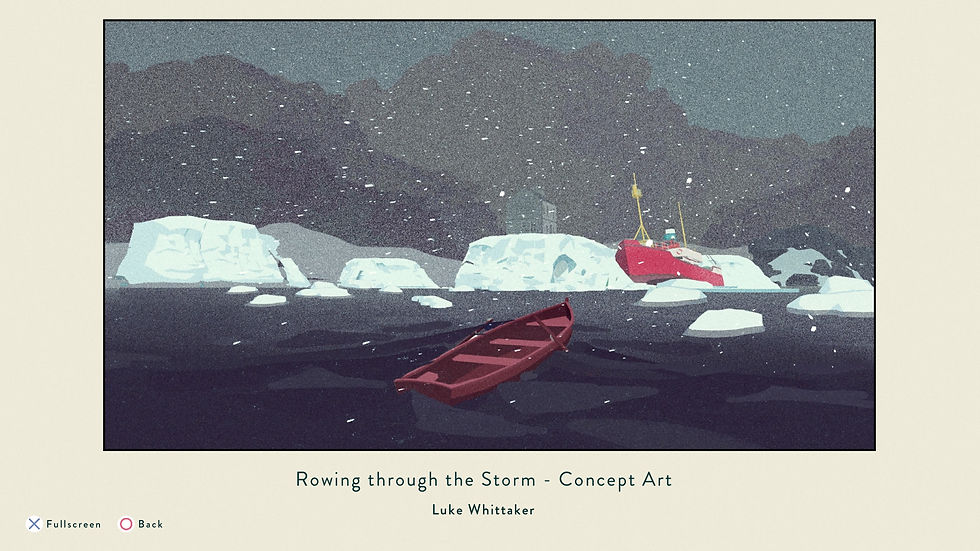
South of the Circle (SOTC) uses a compelling adventure storyline, exquisite artwork, vivid performances, and evocative music to transport the player into two post WWII timelines. The first timeline is your lonely struggle to survive a plane crash in Cold-War era Antarctica. The second is the fragmented memories of your life before the crash.
Contemplating death while slowly trudging through the vast snowfields allows plenty of time to examine your life choices and perhaps… the lies you’ve told yourself to carry on living. As the player avatar searches for help, environmental elements echo places from the past and trigger memories of childhood, university, and his relationship with his professional partner and lover Clara.

As usual, I’m gonna talk about spoilers, so if you’re interested in playing this game, you might want to pause and come back after you’ve played. It’s a short, sweet, and beautiful game that takes 3-4 hours to complete and is $12.99 on Steam and Playstation.
My first note is that this game is a slow burn. That’s a good thing… once you get into it. To put my head-space in context, I’ve been watching playthroughs of AAA games that I don’t have the controller skills to play. I’ve watched hours of Horizon Zero Dawn and Elden Ring fast-action fighting. After that adrenaline, it took me the first hour of play to slow down and savor SOTC.
This game keeps you very much on the rails. You are frequently given two to three choices of how to respond to a situation. You make those choices in situations in present time as well as in situations from memory. The ability to choose how you remember your actions from the past is a key theme. Do I believe I always did the right thing? Did I do the right thing?

There is one scene from the past that is replayed several times during the game. Each time the player has more information about the events that led to the scene. And each successive time that the scene occurs, the player avatar is closer to death. Does that mean the player avatar is closer to remembering his actions truthfully?
Throughout the game, when choices appear, you can also choose to do nothing. If you do, the choices fade away. Except for that one key scene, I am not sure how much these emotional response choices affect the outcome of the game.

The interesting thing is that the choices are presented as abstract geometry, such as red dots or green circles, without indicating the meaning or implication of the choice. The first time these options are presented (shown above), they are annotated with emotional tone indicators. After that, the player is on their own to interpret the meaning of the offered symbol. I did stay away from red — based my assumption that red would always be an inflammatory choice.
So… did the mechanic of choice create emotional engagement for me? I think that it kept me engaged in the story. I did enjoy occasionally doing nothing and seeing where the scene went.
The other mechanic is exploration of spaces. As the player journeys from one abandoned outpost to the next, there are a few opportunities to examine items. Most of these confirmed that the location had been abandoned in a hurry. I’ve read that this game was inspired by What Remains of Edith Finch and Firewatch. I would have liked more items to examine and more of the mini-game environmental puzzles that are found in those inspirational games.

The recurring item that must be tuned in each location, from the plane through each of the outposts, is the radio. This is achieved by turning each radio on and turning the tuning knob until you find a station. It’s a simple mechanic, less difficult than tuning your blurry vision after the bike crash in Florence.
So, in this game, it’s not the mechanics that create emotional engagement, it’s really the strength of the story, the characters, the location, the artwork, performances, and the music. Digging through the after game “Behind the Scenes” artwork and location map of Antarctica was an enjoyable surprise.

And as I am fond of saying, the environment is a character in the game. In this case it is the primary antagonist that provokes all the characters into action and reaction. The art team does a magnificent job of creating landscapes that evoke the beauty and relentless power of nature. I love reading the annotated drawings to gain insight into their design process.

The development team did historical and local research on Cold-War era Britain and Antarctica. Research is one of the great delights of writing and concept development. That’s the adventure in writing -- getting away from our desks, experiencing the real world, and then contemplating how to deliver that experience to the player.

I love fictionalized history – meaning true historic events used as the worldbuilding for a fictional adventure or love story. With SOTC I enjoyed the parallel between the hero’s journey to self-awareness of how he is participating in the cold-war, and my learning, while playing a video game, that Britain, the USSR, and even the US tested atomic weapons in Antarctica.
Of course we did! That’s why I was hiding under my elementary school desk in atomic bomb duck-and-cover drills in the era that this game is set. I conveniently forgot about our participation in the threat of nuclear war. I really appreciate games that bring the messy complexities of history back to life.
In all, South of The Circle is a beautiful thought-provoking game with a compelling history-based adventure love story. I’m glad that I played it.

Comments